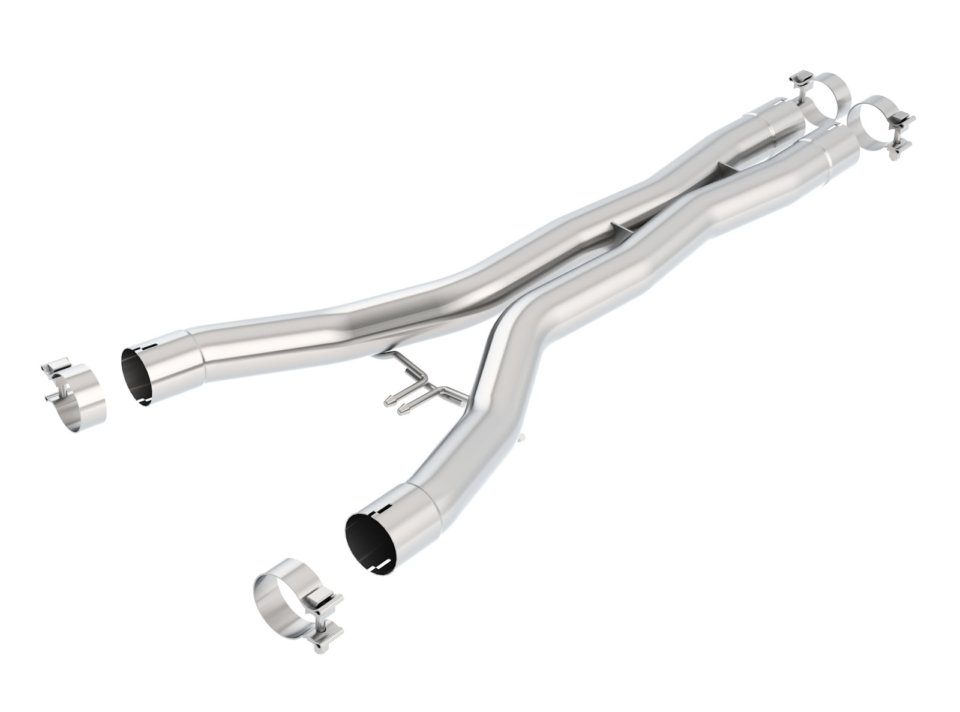There isn’t a more iconic engine sound out there than a well-tuned small-block Chevrolet. I’m preaching to the choir here, I know, but it’s true. It has become the sound of modern performance, and not just in GM products, but swapped into just about anything with wheels. It’s like the Rule 34 of cars: If a vehicle exists, someone has swapped an LS into it.
Anyway, with the engine being so ubiquitous, people often find themselves wanting to tune their exhaust system’s sound to be a little more unique, or tweaked so it doesn’t sound like everything else at the car meet. That brings us to X-pipes and H-pipes. We get asked all the time what the difference is between the two, both in sound and performance, so we thought we would do a deep dive and clear up the confusion.
The simple, quick answer is:
- X-pipes tend to be a little more raspy, higher-pitched, more efficient in terms of horsepower
- H-pipes tend to be low and growly, with more torque and less horsepower
But why?
OK, if you want to go more in-depth, stick with me here. First, let’s talk about what a mid-pipe actually does.
There’s a reason why engines with more than one bank of cylinders (V8s, V6s, flat configurations, etc.) have mid-pipes that connect along the way. Basically the purpose is to equalize the exhaust pulses coming from either side of the engine. As the cylinders on each bank are firing, there is uneven pressure on either side of the exhaust. By connecting at the mid-pipe, that difference is equalized. This can also help with scavenging by reducing backpressure, something I’ll get into below.
Mid-pipes first came around, funnily enough, as a solution to quiet down loud exhaust on cars. This did have a decent effect on the noise (not as much of a difference as mufflers would make down the line), but a happy byproduct was that this resulted in more power. By giving the exhaust on one side a way to escape meant more room for the next wave to follow.
H-pipes
These were the first design to come around, and just by looking at a set, you can tell they weren’t designed from the beginning for outright performance. It doesn’t take a degree in fluid dynamics to come to the conclusion that gases and fluids don’t move as efficiently around sharp, 90-degree turns (more on that in a bit).
So, like I said above, H-pipes tend to result in a low, rumbly sound — think of an old muscle car, because that iconic sound came around at the dawn of the H-pipe. Furthering the old-school sound, the pulse from each bank is much more separated — something that goes hand-in-hand with a lopey cam. These offer the low RPM benefit of venting each side of the exhaust system, but due to the poor flow, the benefit seems to drop off at higher RPM.
X-pipes
These are the evolution of the H-pipe. By gently curving the pipes in towards each other and connecting directly rather than with a connecting pipe, the gases have a much smoother time escaping from side to side. To compare it to traffic, think of the smooth transition of a freeway on-ramp and off-ramp as opposed to a hard 90-degree stoplight.
This results, predictably, in higher flow, less backpressure, more potential for scavenging, and a higher-pitched, raspier sound. These also solve the issue of performance fall-off at high RPM, as there is little in the way of obstruction for the exhaust flow.
What about straight pipe/true duals?
They sound pretty damn cool, don’t they? True dual pipes are where the exhaust is completely separate on each bank, meaning from each header back it’s just one pipe the whole way. This sounds awesome and really rumbles the car around to make it feel like a true muscle car experience. So why isn’t this ideal?
To get that answer, let’s talk scavenging real quick. Basically, scavenging can be thought of as the opposite of backpressure. With good enough exhaust flow, the outgoing gases can create a vacuum behind the pulse. As the valves are opening and closing between cylinder strokes, there is a sweet-spot where the exhaust and intake valves are open at the same time. During this brief moment, that vacuum can help to actively pull in fresh air through the intake valves. Bringing in more air more quickly means more power. That is scavenging.
True dual pipes have more backpressure than the other systems mentioned, and backpressure is the enemy of scavenging. And contrary to what you might hear, backpressure is not the answer for all your torque needs — it’s a fine line to hit.
So which is best for you?
Well, that depends. What are you looking to get out of your exhaust? Maximum performance? The X-pipe is probably for you. Want a lower, rumbly sound? H-pipe all the way. We wouldn’t recommend true duals for anyone but the most hardcore in dedication to the sound and physical (not just audible) rumble of straight pipes.
Unfortunately, this is another case where there is no objectively correct answer. Everyone has their own priorities, and that’s what makes this hobby fun.




















